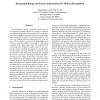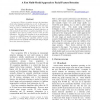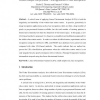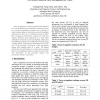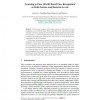109
Voted
JCDL
2005
ACM
15 years 6 months ago
2005
ACM
Our system suggests likely identity labels for photographs in a personal photo collection. Instead of using face recognition techniques, the system leverages automatically availab...
116
Voted
WACV
2005
IEEE
15 years 6 months ago
2005
IEEE
The performance of face recognition systems that use two-dimensional images depends on consistent conditions w.r.t. lighting, pose, and facial appearance. We are developing a face...
111
click to vote
WACV
2005
IEEE
15 years 6 months ago
2005
IEEE
As interest in 3D face recognition increases the importance of the initial alignment problem does as well. In this paper we present a method utilizing the registered 2D color and ...
122
click to vote
SIBGRAPI
2005
IEEE
15 years 6 months ago
2005
IEEE
A critical issue of applying Linear Discriminant Analysis (LDA) is both the singularity and instability of the within-class scatter matrix. In practice, particularly in image recog...
127
click to vote
MMM
2005
Springer
15 years 6 months ago
2005
Springer
The canonical face recognition algorithm Eigenface and Fisherface are both based on one dimensional vector representation. However, with the high feature dimensions and the small ...
116
Voted
ICMCS
2005
IEEE
15 years 6 months ago
2005
IEEE
This paper describes a novel SOM-Wavelet Networks method for face recognition. We employed a SOM algorithm, which is based on the structure of a biological model, to extract shape...
135
Voted
ICIP
2005
IEEE
15 years 6 months ago
2005
IEEE
— This paper proposes a face recognition system that uses (i) passive stereo vision to capture three-dimensional (3D) facial information and (ii) 3D matching using a simple ICP (...
123
click to vote
CRV
2005
IEEE
15 years 6 months ago
2005
IEEE
Face recognition in video has gained wide attention as a covert method for surveillance to enhance security in a variety of application domains (e.g., airports). A video contains ...
122
Voted
AMFG
2005
IEEE
15 years 6 months ago
2005
IEEE
This paper proposes the AdaBoost Gabor Fisher Classifier (AGFC) for robust face recognition, in which a chain AdaBoost learning method based on Bootstrap re-sampling is proposed an...
111
click to vote
AMFG
2005
IEEE
15 years 6 months ago
2005
IEEE
2D intensity images and 3D shape models are both useful for face recognition, but in different ways. While algorithms have long been developed using 2D or 3D data, recently has see...

